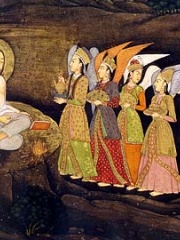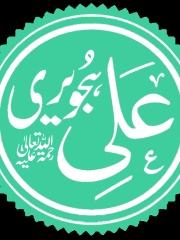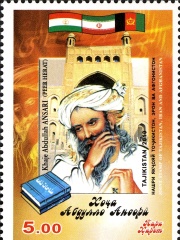



The Most Famous
RELIGIOUS FIGURES from Afghanistan
This page contains a list of the greatest Afghan Religious Figures. The pantheon dataset contains 3,187 Religious Figures, 5 of which were born in Afghanistan. This makes Afghanistan the birth place of the 64th most number of Religious Figures behind Tunisia, and Armenia.
Top 5
The following people are considered by Pantheon to be the most legendary Afghan Religious Figures of all time. This list of famous Afghan Religious Figures is sorted by HPI (Historical Popularity Index), a metric that aggregates information on a biography's online popularity.

1. Abu Dawood (817 - 888)
With an HPI of 74.69, Abu Dawood is the most famous Afghan Religious Figure. His biography has been translated into 38 different languages on wikipedia.
Abū Dāwūd (Dā’ūd) Sulaymān ibn al-Ash‘ath ibn Isḥāq al-Azdī al-Sijistānī (Arabic: أبو داود سليمان بن الأشعث الأزدي السجستاني), commonly known as Abū Dāwūd al-Sijistānī, was a scholar of prophetic hadith who compiled the third of the six "canonical" hadith collections recognized by Sunni Muslims, the Sunan Abu Dāwūd.

2. Ibrahim ibn Adham (718 - 782)
With an HPI of 69.04, Ibrahim ibn Adham is the 2nd most famous Afghan Religious Figure. His biography has been translated into 23 different languages.
Ibrahim ibn Adham also called Ibrahim Balkhi and Ebrahim-e Adham (Persian: ابراهیم ادهم); c. 718 – c. 782 / AH c. 100 – c. 165 is one of the most prominent of the early Sufi saints known for his zuhd (asceticism). The story of his conversion is one of the most celebrated in Sufi legend, mentioned in the Tazkirat al-Awliya of Attar of Nishapur . Sufi tradition ascribes to Ibrahim countless acts of righteousness and his humble lifestyle, which contrasted sharply with his early life as the king of Balkh (itself an earlier centre of Buddhism). As recounted by Abu Nu'aym al-Isfahani, Ibrahim emphasized the importance of stillness and meditation for asceticism. Rumi extensively described the legend of Ibrahim in his Masnavi. The most famous of Ibrahim's students is Shaqiq al-Balkhi (d. 810).

3. Ali Hujwiri (1009 - 1072)
With an HPI of 65.38, Ali Hujwiri is the 3rd most famous Afghan Religious Figure. His biography has been translated into 19 different languages.
Abu al-Hasan Ali ibn Uthman al-Jullabi al-Hujwiri (Persian: ابو الحسن علی بن عثمان الجلابی الھجویری, romanized: Abū al-Ḥasan ʿAlī ibn ʿUthmān al-Jullābī al-Hujwīrī; c. 1009-1072/77), known reverentially as Data Sahib (Persian: داتا صاحب, romanized: Dātā Ṣaḥib), was an Islamic scholar and mystic who authored Kashf al-Mahjub, the earliest treatise on Sufism in the Persian language. Born in the Ghaznavid Empire, al-Hujwiri is believed to have contributed "significantly" to the spread of Islam in South Asia through his preaching. Al-Hujwiri is venerated as the primary saint of Lahore, Pakistan by the Sufis of the area and his tomb-shrine, known as the Data Darbar, is one of the most frequented shrines in South Asia. Currently, it is Pakistan's largest shrine "in numbers of annual visitors and in the size of the shrine complex," and, having been nationalized in 1960, is managed today by the Department of Awqaf and Religious Affairs of the Punjab. The mystic himself remains a "household name" in the daily Islam of South Asia. In 2016, the Government of Pakistan declared 21 November to be a public holiday for the commemoration of the commencement of Ali Hujwiri's three-day death anniversary.

4. Khwaja Abdullah Ansari (1006 - 1089)
With an HPI of 64.35, Khwaja Abdullah Ansari is the 4th most famous Afghan Religious Figure. His biography has been translated into 26 different languages.
Abu Ismaïl Abdullah al-Harawi al-Ansari or Abdullah Ansari of Herat (1006–1089) (Persian: خواجه عبدالله انصاری) also known as Pir-i Herat (پیر هرات) "Sage of Herat", was a Sufi saint, who lived in Herat, Ghaznavid Empire (modern-day Afghanistan). Ansari was a commentator on the Qur'an, scholar of the Hanbali school of thought (madhhab), traditionalist, polemicist and spiritual master, known for his oratory and poetic talents in Persian language.

5. Abdul Rahman (b. 1965)
With an HPI of 50.87, Abdul Rahman is the 5th most famous Afghan Religious Figure. His biography has been translated into 20 different languages.
Abdul Rahman (Dari: عبدالرحمن; born 1965) is an Afghan man whose arrest and trial in February 2006 sparked widespread controversy among the international community. Abdul Rahman had been arrested by Afghan authorities for apostasy and subsequently threatened with the death penalty. He had converted to Christianity from Islam while providing medical assistance to Afghan refugees in Peshawar, Pakistan. On 26 March 2006, under heavy pressure from foreign governments, the Afghan court returned his case to prosecutors, citing "investigative gaps"; Abdul Rahman was released from prison and remanded to his family on the night of 27 March. On 29 March, Abdul Rahman arrived in Italy after being offered asylum by the Italian government. Representatives within the Afghan government and many Afghan citizens continued to call for Abdul Rahman's execution, and his wife divorced him shortly after his conversion, leading to an unsuccessful custody battle for their two children. The case became a cause célèbre internationally, and particularly throughout the Western world. Harsh condemnation came from the United States and the United Kingdom, both of which were the world's leading donors of international aid to Afghanistan at the time. The Afghan government's integrity was called into question, as it had recently been established under the aegis of the War in Afghanistan, shortly after an American-led military coalition overthrew the country's Taliban government.
People
Pantheon has 5 people classified as Afghan religious figures born between 718 and 1965. Of these 5, 1 (20.00%) of them are still alive today. The most famous living Afghan religious figures include Abdul Rahman. The most famous deceased Afghan religious figures include Abu Dawood, Ibrahim ibn Adham, and Ali Hujwiri.
Living Afghan Religious Figures
Go to all RankingsDeceased Afghan Religious Figures
Go to all RankingsAbu Dawood
817 - 888
HPI: 74.69
Ibrahim ibn Adham
718 - 782
HPI: 69.04
Ali Hujwiri
1009 - 1072
HPI: 65.38
Khwaja Abdullah Ansari
1006 - 1089
HPI: 64.35

